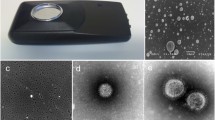Summary
Influenza A virus, strain WSNH, propagated in bovine, human and chick embryo cell cultures and aerosolized from the cell culture medium, was maximally stable at low relative humidity (RH), minimally stable at mid-range RH, and moderately stable at high RH. Most lots of WSNH virus propagated in embryonated eggs and aerosolized from the allantoic fluid were also least stable at mid-range RH, but two preparations after multiple serial passage in eggs showed equal stability at mid-range and higher RH's. Airborne stability varied from preparation to preparation of virus propagated both in cell culture and embryonated eggs. There was no apparent correlation between airborne stability and protein content of spray fluid above 0.1 mg/ml, but one preparation of lesser protein concentration was extremely unstable at 50 to 80 per cent RH. Polyhydroxy compounds exerted a protective effect on airborne stability.
Similar content being viewed by others
References
Akers, T. G.: Survival of airborne virus, phage and other minute microbes. In:Dimmick, R. L., Akers, A. B. (eds.), An Introduction to Experimental Aerobiology, 296–339. New York: Wiley—Interscience 1969.
Akers, T. G.: Some aspects of the airborne inactivation of viruses. In:Hers, J. F. P., Winkler, K. C. (eds.), Airborne Transmission and Airborne Infection, 73–81. Utrecht: Oosthoek Publ. Co. 1973.
Benbough, J. E.: The effect of relative humidity on the survival of airborne Semliki Forest virus. J. gen. Virol.4, 473–477 (1969).
Benbough, J. E.: Some factors affecting the survival of airborne viruses. J. gen. Virol.10, 209–220 (1971).
Borecky, L., Lackovic, V., Rathova, V.: Surface properties of the egg and mouse lines of A 1 influenza virus. J. Immunol.95, 387–395 (1965).
Chatigny, M. A., Wolochow, H., Leif, W. R., Hebert, J.: The toxicity of nitrogen oxides for an airborne microbe: Effects of relative humidity test procedures and containment and composition of spray suspension. In:Hers, J. F. P., Winkler, K. C. (eds.), Airborne Transmission and Airborne Infection, 94–97. Utrecht: Oosthoek Publ. Co. 1973.
Choppin, P. W.: Replication of influenza virus in a continuous cell line: High yield of infective virus from cells inoculated at high multiplicity. Virology39, 130–134 (1969).
Compans, R. W., Choppin, P. W.: The structure and assembly of influenza and parainfluenza viruses. In:Maramorosch, K., Kurstak, E. (eds.), Comparative Virology, 407–432. New York: Academic Press, Inc. 1971.
de Jong, J. C., Trouwborst, T., Winkler, K. C.: The mechanism of virus decay in aerosols. In:Hers, J. F. P., Winkler, K. C. (eds.), Airborne Transmission and Airborne Infection, 124–130. Utrecht: Oosthoek Publ. Co. 1973.
Dimmick, R. L.: Production of biological aerosols. In:Dimmick, R. L., Akers, A. B. (eds.), An Introduction to Experimental Aerobiology, 22–45. New York: Wiley—Interscience 1969.
Harper, G. J.: Airborne microorganisms: Survival tests with four viruses. J. Hyg. (Camb.)59, 479–486 (1961).
Harper, G. J.: The influence of environment on the survival of airborne virus particles in the laboratory. Arch. ges. Virusforsch.13, 64–71 (1963).
Hearn, H. J., Jr., Soper, W. T., Miller, W. S.: Loss of virulence of yellow fever virus serially passed in HeLa cells. Proc. Soc. exp. Biol. Med.119, 319–322 (1965).
Hemmes, J. H., Winkler, K. C., Kool, S. M.: Virus survival as a seasonal factor in influenza and poliomyelitis. Nature188, 430–431 (1960).
Hood, A. M.: Infectivity of influenza virus aerosols. J. Hyg. (Camb.)61, 331–335 (1963).
Kilbourne, E. D.: Plaque formation by influenza viruses, In:Habel, K., Salzman, M. P. (eds.), Fundamental Techniques in Virology, 146–160. New York: Academic Press, Inc. 1969.
Lazarowitz, S. G., Goldberg, A. R., Choppin, P. W.: Proteolytic cleavage by plasmin of the HA polypeptide of influenza virus: host cell activation of serum plasminogen. Virology56, 172–180 (1973).
Lowry, O. H., Rosebrough, N. J., Farr, A. L., Randall, R. J.: Protein measurement with the Folin phenol reagent. J. biol. Chem.193, 265–275 (1951).
Rechsteiner, J., Winkler, K. C.: Inactivation of respiratory syncytial virus in aerosol. J. gen. Virol.5, 405–410 (1969).
Shechmeister, I. L.: Studies on the experimental epidemiology of respiratory infections. III. Certain aspects of the behavior of type A influenza virus as an airborne cloud. J. inf. Dis.87, 128–132 (1950).
Spendlove, R., Taylor, F. L.: A rack for expediting the manipulation of tissue culture bottles with an application to the viral plaque technique. Amer. J. clin. Pathol.40, 34–37 (1963).
Webb, S. J., Bather, R., Hodges, R. W.: The effect of relative humidity and inositol on airborne viruses. Canad. J. Microbiol.9, 87–92 (1963).
Zitcer, E. M., Bruening, G., Agrawal, H. O.: The multiplication of an influenza virus strain in a continuous line of mammalian cells. Arch. ges. Virusforsch.20, 137–141 (1967).
Author information
Authors and Affiliations
Additional information
With 2 Figures
Rights and permissions
About this article
Cite this article
Schaffer, F.L., Soergel, M.E. & Straube, D.C. Survival of airborne influenza virus: Effects of propagating host, relative humidity, and composition of spray fluids. Archives of Virology 51, 263–273 (1976). https://doi.org/10.1007/BF01317930
Received:
Accepted:
Issue Date:
DOI: https://doi.org/10.1007/BF01317930




